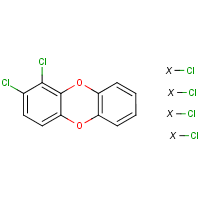Hexachlorodibenzo-p-dioxin
Agent Name
Hexachlorodibenzo-p-dioxin
CAS Number
34465-46-8
Formula
C12-H2-Cl6-O2
Major Category
Other Classes

Synonyms
HCDD; Hexachlorodibenzo-4-dioxin; Dibenzo(b,e)(1,4)dioxin, hexachloro-; Dibenzo-p-dioxin, hexachloro-; Hexachlorodibenzodioxin; [ChemIDplus]
Category
Halogenated Polyaromatics
Sources/Uses
Found as impurity in pesticides and pentachlorophenol (wood preservative); Produced from combustion of coal, refuse, wood, cigarettes, and materials containing PVC; Also found in municipal waste water and effluents from pulp and paper manufacture (when chlorine used for bleaching); Not commercially produced; [HSDB]
Comments
IARC classification is for polychlorinated dibenzo-para-dioxins other than 2,3,7,8-Tetrachlorodibenzo-p-dioxin (TCDD); Polychlorodibenzodioxins have caused chloracne in humans; Occupational exposure may occur from contact with contaminated compounds (i.e. pesticides and pentachlorophenol), in metal reclamation, or during manufacture of chlorophenols; 1,2,3,4,7,8- isomer oral LD50 (rat) = 0.887 mg/kg; Effects in high-dose feeding studies with rats include hemorrhage, anemia, wasting syndrome, and changes in liver enzyme activity; Some evidence of increase in tumor frequency and teratogenicity; [HSDB] Significant exposure more likely through breast milk than transplacentally; Similar toxicity to TCDD, but less potent; [REPROTOX]
Biomedical References
Exposure Assessment
Vapor Pressure
4.4E-11 mm Hg
Adverse Effects
Hepatotoxin
Hepatoxic (a) from occupational exposure (secondary effect) or (b) in animal studies or in humans after ingestion
Reproductive Toxin
Yes
Dermatotoxin
Chloracne
IARC Carcinogen
Not classifiable
Diseases, Processes, and Activities Linked to This Agent
Diseases
Occupational diseases associated with exposure to this agent: